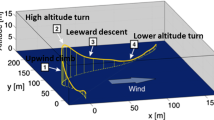Abstract
Current methods of airdropping payloads accurately use the autonomously guided parafoil systems. Such approaches have limited trajectory options, hence limited accuracy, and could deliver only one payload with one airdrop. The Samara Autorotating Wings (SAW) is disposable type of aerial deployment system proposed in this paper to drop light-weight electronic payloads to remote locations accurately. Using autorotation as its main technique of lift creation, the concept borrows the natural dispersion method from maple seeds and takes advantage of the gyroscopic stability of a spinning mass. It does not require any propulsion system on-board and is equipped with an actuator to change the angle of attack of the wing for directional control. The concept also features a collaborative autorotation mode whereby multiple wings are attached together to form a larger rotor hub that benefits from increased angular momentum and control authority which is especially important at higher altitudes where the air is less dense. Although there have been other works on using autorotation to deliver payloads, this is the first documented effort in using a collaborative form of autorotation. The chordwise geometrical wing shape of SAW is optimized to achieve the maximum lift force during its autorotating descent. A nonlinear control method is conceived to regulate the descent direction and speed of SAW. This proposed control scheme enables an omni-directional guide slope, allowing SAW to be more maneuverable than parafoils or fixed-wing type of aerial deployments. SAW with different numbers of wings are tested against each other for drop characteristics and control performance, in simulated models and in physical experiments that involve a vertical wind tunnel with and integrated motion-captured system and free-fall drop tests.















Similar content being viewed by others
References
Alvissalim, M.S., Zaman, B., Hafizh, Z.A., Ma’sum, M.A., Jati, G., Jatmiko, W., Mursanto, P.: Swarm quadrotor robotics for telecommunication network coverage area axpansion in disaster area. In: SICE annual conference, pp. 2256–2261, Japan, IEEE (2012)
Benney, R., Barber, J., McGrath, J., McHugh, J., Noetscher, G., Tavan, S.: The new military applications of precision airdrop systems. Am. Inst. Aeronaut. Astronaut. 7069, 1–16 (2005)
Bishop, J., Meloni, A., Benney, R.: Precision airdrop technology conference and demonstration 2007. PATCAD 2007 (2007)
Corke, P., Hrabar, S., Peterson, R., Rus, D., Saripalli, S., Sukhatme, G.: Deployment and connectivity repair of a sensor net with a flying robot, pp. 333–343. Exp. Robotics, IX (2006)
Crimi, P.: Analytic modelling of a samara-wing decelerator. In: 9th Aerodynamic Decelerator and Balloon Technology Conference, American Institute of Aeronautics and Astronautics, pp. 86–2439 (1986)
Diebel, J.: Representing attitude: Euler angles, unit quaternions, and rotation vectors. Stanford University, California (2006)
Ezabadi, M., Sabeti, M., Banazadeh, A.: Dynamics identification of a monocopter using neural networks. Int. J. Modeling Optim. 7, 179–183 (2017)
Fregene, K., Bolden, C.: Dynamics and control of a biomimetic single-wing nano air vehicle. In: American Control Conference, pp. 51–56 (2010)
Gessow, A., Myers, G.: Aerodynamics of the helicopter. College Park Press, Silver Spring (1999)
Houghton, J., Hoburg, W.: Fly-by-wire control of a monocopter. Massachusetts: Techincal Report, Massachusetts Institute of Technology (2007)
Kellas, A.: The guided samara: design and development of a controllable single-bladed autorotating vehicle. Master Thesis, Massachusetts Institute of Technology (2007)
Lee, E.-J., Lee, S.-J.: Effect of initial attitude on autorotation flight of maple samaras (acer palmatum). J. Mech. Sci. Technol. 30(2), 741–747 (2016)
Leishman, J.: Principles of Helicopter Aerodynamics. Cambridge University Press, Cambridge (2002)
Pounds, P., Singh, S.: Integrated electro-aeromechanical structures for low-cost, self-deploying environment sensors and disposable uavs. In: IEEE International Conference on Robotics and Automation, pp. 4444–4451 (2013)
Song, W.Z., Huang, R., Xu, M., Ma, A., Shirazi, B., LaHusen, R.: Air-Dropped Sensor Network for Real-Time High-Fidelity Volcano Monitoring, pp. 305–318. Association for Computing Machinery, New York (2008)
Stevens, B., Lewis, F., Johnson, E.: Aircraft Control and Simulation: Dynamics, Controls Design, and Autonomous Systems, 3rd edn. Wiley, Hoboken (2015)
Ulrich, E., Humbert, J., Pinse, D.: Pitch and heave control of a robotic samara micro air vehicles. J. Aircraft 47(4), 1290–1299 (2010a)
Ulrich, E., Pines, D., Humbert, J.: From falling to flying: the path to powered flight of a robotic samara nano air vehicle. Bioinspiration Biomimetics 5(2010), 045009 (2010b)
US Naval Research Lab: Retrieved 06 07, 2018 (2006). http://www.nrl.navy.mil/tewd/organization/5710/5712/research/CICADA. Accessed 6 July 2018
Varshney, K., Chang, S., Wang, Z.: The kinematics of falling maple seeds and the initial transition to a helical motion. Nonlinearity 25, C1–C8 (2012)
Waharte, S., Trigoni, N., Julier, S.: Coordinated search with a swarm of UAVs. In: IEEE Annual Communications Society Conference on Sensor, Mesh and Ad Hoc Communications with Networks Workshops. Rome, Italy: IEEE (2009)
Wick, B.: Study of the subsonic forces and moments on an inclined plate of infinite span. NACA TN-3221 (1954)
Win, S., Goh, T., Low, J., Shaiful, D., Win, L., Soh, G., Foong, S.: Direction controlled descent of samara autorotating wings (saw) with n-wings. In: IEEE International Conference on Robotics and Automation. Brisbane (2018)
Win, S., Tan, C., Shaiful, D., Low, J., Soh, G., Foong, S.: The effects of chordwise wing optimization of single-winged samara in autorotation. In: IEEE international conference on advanced intelligent mechatronics. Munich (2017)
Yasuda, K., Azuma, A.: The autorotation boundary in the flight of samaras. J. Theor. Biol. 185, 313–320 (1996)
Acknowledgements
This work was funded jointly by the SUTD-MIT International Design Centre and the Temasek Laboratories@SUTD, Singapore.
Author information
Authors and Affiliations
Corresponding author
Additional information
Publisher's Note
Springer Nature remains neutral with regard to jurisdictional claims in published maps and institutional affiliations.
Rights and permissions
About this article
Cite this article
Win, S.K.H., Win, L.S.T., Soh, G.S. et al. Design, modelling and control of collaborative samara autorotating wings (SAW). Int J Intell Robot Appl 3, 144–157 (2019). https://doi.org/10.1007/s41315-019-00091-6
Received:
Accepted:
Published:
Issue Date:
DOI: https://doi.org/10.1007/s41315-019-00091-6




